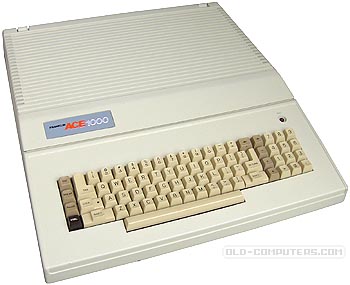ACE-1000/1100/1200
The ACE-1000 series was being worked on when I joined Franklin. I had one on my desk for most of my employment, and still have the same machine in my basement. It was the most successful product Franklin made, and while nobody seems to know the exact number produced, it was in the tens-of-thousands.

There were multiple machines in this series, all based on the same ACE-1000 chassis. The only difference was that the plain top of the ACE-1000 was replaced with an enclosure that held one or two disk drives, producing the ACE-1100 and ACE-1200 models. Internally they were identical.
Hard Boot vs Soft Boot
There are two main versions of the motherboard. The original was just a smaller version of the ACE-100 motherboard, i.e., a copy of the Apple. However, it did not include color because of Apple patents. I forget the steps, but adding color was a fairly minor operation that involved a trace cut or two, then the color circuitry would function exactly like the Apple’s.
Mike Wajda spent almost all of his time working out ways to get around the Apple color patents and finally came up with a method that involved installation of rather unwieldy board that sat under the keyboard. A few parts were removed from the motherboard, a few wires soldered to it, and the board plugged into a large chip on the very front row. Ugly.
It still had all the BASIC and monitor code in EPROMs.
The soft boot was meant as a way around the legal issues. The idea was to put as little into ROM as possible, then load all the potentially legal questionable material onto the disks. The only thing in ROM was the boot loaded, i.e., the soft boot code. It would start up drive 1 and look for the BASIC images on disk, load them into memory, then transfer to BASIC. Cool idea. Who came up with the idea is debated, but it was either Dave McWherter or Frank Kautzmann III. Dave was definitely the person who implemented and perfected it. Dave’s handwriting is on the EPROM label of one of my soft boot motherboards that was used inside Engineering.
In order to implement this, the motherboard had some enhancements. First, it had 64K implemented with 4164 RAM chips, so only 8 were needed, not 32. The motherboard also had an integrated disk controller permanently wired to slot 6 so the boot code always knew which slot to use. The actual slot 6 existed, but had a block in it to prevent someone from plugging in a disk card. There are two disk drive plugs where the drive cables plug in, and on my board they are mislabeled, i.e., DISK 1 is actually disk 2.
Alternate BASICs
One of the points of contention with Apple was the BASIC, so we hired outside companies to write compatible BASICs without using any Franklin engineers. Dave McWherter, Dave Warker and I provided some consulting to them, but they worked independently from Dave W and I, and turned all code to Dave M for testing. The in-house engineers were tainted because we were well versed in the code in the EPROMs, so we’d have outside companies write code to our specifications.
ACE-1100 and ACE-1200

Someone had the idea that having disk drives integrated into the case would be a good idea. In theory, it was a great idea! Less cables, drives didn’t wander around as you popped disks in and out, etc. The mechanical design was simple enough: replace the default “flat” lid with a bigger one and mount two drives in it. Things weren’t quite that wonderful. The two drives were bolted to a metal plate at the bottom of the lid, then the plate was screwed to the lid. There wasn’t much ventilation, so the computer (the standard ACE-1000) tended to overheat and fail. The Hardware guys had the newfangled 1200 models, while the software guys were using 1000s and 100s, so we didn’t have the problem. It was customary to see the lids 1100 and 1200 computers propped open in the back so they could get rid of the excess heat coming from the motherboard and peripheral cards.
A few years ago, Joel Shusterman, one of the three founders of Franklin, gave me a different take on this. They were offered a good deal on bare disk drives, which they jumped on. Now there was a warehouse filled with drives that were selling, but apparently lots of people used third-party disk drives rather than the ACE-10 drive. Joel said they decided to integrate the drives into the machines in order to sell more of the raw drives and clear out the warehouse.
The ACE-1100 had one drive, the ACE-1200 had two.